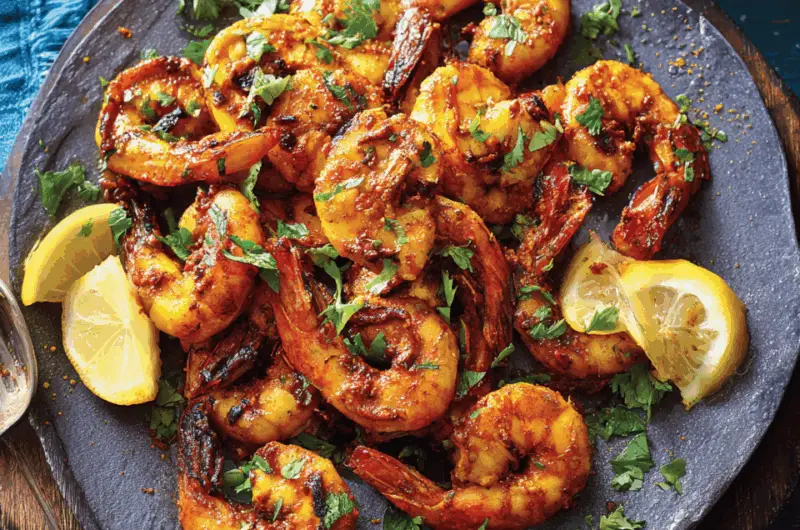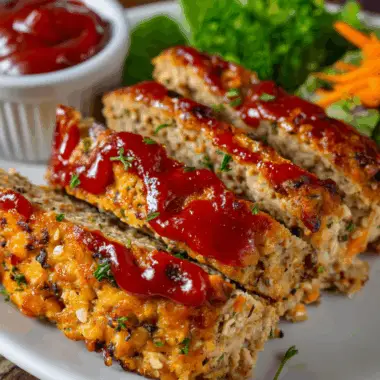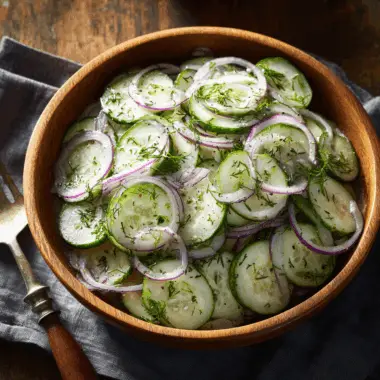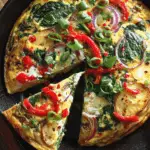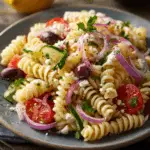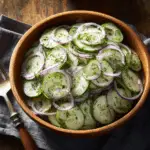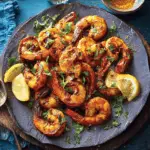The coastal aromas of India come alive in this smoky and vibrant grilled shrimp dish, inspired by the Konkan region. With the rich nuttiness of toasted coconut, the earthy warmth of coriander, the tang of tamarind, and just the right hint of chili, every bite tells a story of spice, sun, and seaside flavors.
Quick to prepare and impossible to forget, these shrimp are a grilling dream—perfectly charred outside, tender and juicy inside. Serve them at your next BBQ with fresh lemon wedges and herbs, and watch your guests go back for seconds. Whether you’re new to Indian cooking or a seasoned masala master, this recipe is a surefire crowd favorite.
Full Recipe:
-
1 pound large or extra-large raw shrimp, peeled and deveined
-
3/4 teaspoon kosher salt
-
1/2 teaspoon ground turmeric
-
Canola oil (divided, for cooking and grilling)
-
4 dried Byadgi chiles or 3 dried Kashmiri chiles
-
3 tablespoons unsweetened desiccated coconut powder
-
1 tablespoon whole coriander seeds
-
5 cloves garlic, chopped
-
1 small shallot, thinly sliced
-
3 tablespoons homemade tamarind paste (or 1 tbsp store-bought paste + 2 tbsp water)
-
3 tablespoons water
-
1/2 cup fresh cilantro, minced (for garnish)
-
1 lemon, cut into wedges (for serving)
-
Metal or wooden skewers (if wooden, soak in water for 20 minutes)
Directions:
-
In a bowl, toss shrimp with salt and turmeric. Refrigerate, covered, while preparing the paste.
-
In a skillet, heat 1 tsp canola oil on medium. Toast the chiles for about 2 minutes until aromatic. Remove and let cool.
-
In the same skillet, lower heat to medium-low. Toast coconut powder until golden, about 2 minutes. Set aside.
-
Wearing gloves, stem and deseed the cooled chiles. Roughly chop, then grind into a powder. Measure 1 ½ tsp for mild or 1 tbsp for medium heat.
-
In a food processor, blend chili powder, coconut, coriander seeds, garlic, shallot, tamarind paste, and water until smooth.
-
In a clean skillet over medium heat, add 2 tbsp oil. Cook the masala paste until it darkens and thickens (about 2 minutes). Let cool.
-
Preheat grill to medium-high (400°F–450°F).
-
Toss shrimp with cooled paste until evenly coated. Thread shrimp onto skewers, spacing each piece slightly.
-
Oil grill grates using a paper towel dipped in canola oil.
-
Grill shrimp for 2 minutes per side, or until opaque and lightly charred.
-
Serve hot, garnished with cilantro and lemon wedges.
Prep Time: 20 minutes | Cooking Time: 10 minutes | Total Time: 30 minutes
Kcal: 213 kcal | Servings: 4 servings
A Taste of India’s Konkan Coast: The Story Behind Grilled Shrimp with Masala Paste
Shrimp is a globally loved seafood, but when infused with Indian spices and grilled to perfection, it becomes something unforgettable. Grilled Shrimp with Masala Paste is a dish that speaks volumes about regional flavor, traditional methods, and culinary innovation. This recipe, inspired by the tropical Konkan region of India, brings together elements of spice, coconut, heat, and tang in a beautifully harmonized way. More than just a meal, it’s a cultural experience delivered in a bite.
Culinary Inspiration from the Konkan Coast
The Konkan region, stretching along India’s western coastline through Goa, Maharashtra, and parts of Karnataka, is known for its bold and distinctive cuisine. The area’s tropical climate and proximity to the Arabian Sea influence both the ingredients and cooking methods. Coconut, tamarind, and chili form the backbone of many dishes in Konkani cuisine, lending a perfect blend of sweetness, sourness, and spice.
This shrimp recipe draws its essence from that rich heritage. The use of a deeply flavorful masala paste rather than a typical marinade distinguishes it from other grilled seafood dishes. Unlike marinades that need time to infuse, this paste is packed with roasted, concentrated flavor that coats the shrimp directly, making it perfect for quick preparation without compromising on complexity.
What Makes Konkani Masala Unique?
At the heart of this dish is the Konkani-style masala, a spice paste that combines toasted desiccated coconut, dried chilies, coriander seeds, tamarind, garlic, and shallots. Each ingredient brings a crucial note to the flavor profile. The coconut adds body and richness, chilies bring color and heat, tamarind delivers a tangy brightness, and the garlic-shallot combo infuses depth and savoriness.
The technique of dry-roasting spices and coconut is integral to South Indian and coastal cooking. It not only intensifies the flavors but also removes excess moisture, helping the paste cling better to proteins like shrimp when grilling. In this recipe, the masala is briefly cooked in oil after blending, further enhancing its flavor and helping it develop a slightly caramelized, earthy character.
A Balanced Flavor Profile
One of the highlights of this grilled shrimp dish is its nuanced flavor profile. There’s spice, but it’s not overpowering; a subtle sweetness from the coconut; sourness from the tamarind; and umami from the shrimp itself. This equilibrium makes the dish appealing to a wide range of palates, even those unfamiliar with Indian flavors.
You can adjust the spice level easily by using fewer dried chilies or substituting them with milder alternatives. Byadgi and Kashmiri chilies are preferred in this recipe not just for their heat but for their brilliant red color, which gives the shrimp an appetizing hue without overwhelming fire.
Shrimp as a Canvas for Global Flavors
Shrimp is one of the most versatile seafood options available. Its mild, slightly sweet flavor and firm texture make it an ideal candidate for absorbing marinades, rubs, and pastes. In this dish, shrimp becomes a vessel for the complex Konkani masala, which clings beautifully to its surface while allowing the natural sweetness of the seafood to shine through.
Grilling intensifies that effect. The high heat caramelizes the sugars in the paste and crisps the edges of the shrimp, creating an irresistible contrast of flavors and textures: smoky, spicy, sweet, and succulent.
Grilling Techniques That Maximize Flavor
This recipe is designed with grilling in mind. Whether you’re using a gas or charcoal grill, the objective is to achieve a quick sear that locks in moisture while allowing the masala paste to develop a charred crust.
Using skewers ensures even cooking and makes the shrimp easier to handle on the grill. Threading the shrimp with a slight curve and leaving space between each piece prevents overcrowding, which can lead to steaming rather than searing.
A quick tip: always oil your grill grates before placing the shrimp down. This prevents sticking and allows for beautiful grill marks. And remember, shrimp cook quickly — two to three minutes per side is all you need for perfectly cooked seafood.
Pairing Ideas for a Complete Meal
While these grilled shrimp skewers can stand proudly on their own, they also shine as part of a larger spread. For a fresh and vibrant side, consider serving them with:
-
Coconut rice or lemon rice
-
Mango and cilantro slaw
-
Watermelon and mint salad
-
Grilled naan or flatbreads
-
Cucumber-yogurt raita for cooling contrast
The tangy, spicy notes of the shrimp pair well with cooling or slightly sweet sides, which help balance the overall flavor and make the meal feel complete. A squeeze of fresh lemon or lime over the top adds an extra pop of brightness that enhances all the underlying flavors.
Cultural Significance and Modern Appeal
While rooted in tradition, this dish is incredibly adaptable to modern lifestyles. It’s gluten-free, low in carbs, and high in protein, which makes it suitable for a variety of dietary preferences. It’s also a perfect recipe for those exploring Indian cuisine for the first time, offering bold flavor without the intimidation of unfamiliar techniques or ingredients.
For home cooks interested in global flavors, this recipe provides a fantastic entry point into Indian coastal cooking. The ingredients are increasingly available in mainstream grocery stores, and the process is streamlined enough for weeknight dinners while being impressive enough for entertaining.
Why This Dish Deserves a Spot on Your Summer Menu
There’s something inherently summery about grilled seafood, and this Konkani-style shrimp hits all the right notes. It’s light yet satisfying, quick to prepare, and deeply flavorful. As grilling season ramps up, recipes like this offer a refreshing alternative to typical BBQ fare.
It’s also highly customizable. Don’t eat shrimp? Try the same masala paste on firm white fish like halibut or tilapia. Want to go vegetarian? It works beautifully on grilled tofu, eggplant, or cauliflower steaks. The core flavors remain intact, allowing for creative flexibility based on your needs.
Tips for Perfect Execution
Here are a few expert pointers to get the best results:
-
Use fresh or properly thawed shrimp for the best texture.
-
Do not overcook the shrimp. They should be opaque and slightly firm to the touch.
-
Toast your spices properly — this step cannot be skipped as it’s the foundation of flavor.
-
Let the masala paste cool before mixing with the shrimp, or it may start to cook them prematurely.
-
Serve immediately. Grilled shrimp are best eaten hot and fresh for the juiciest results.
Conclusion: A Flavorful Journey Worth Taking
Grilled Shrimp with Masala Paste is more than just a recipe — it’s a celebration of regional Indian cooking, adapted for the modern kitchen. The Konkani masala brings tradition and technique together in a dish that is both approachable and impressive. It’s a feast of textures and tastes, rich in spice but never overpowering, with a balance that highlights the natural flavor of shrimp.
Whether you’re hosting a summer cookout, looking to spice up your dinner rotation, or exploring new culinary traditions, this dish is a perfect choice. It’s proof that bold, authentic flavors don’t have to come at the expense of simplicity — and that the best meals are the ones that tell a story.

